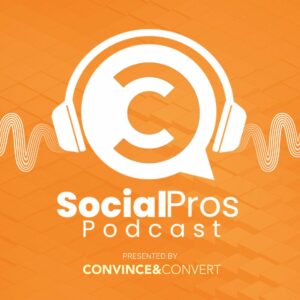Hosted By



Apple Podcast Reviews:
The Social Pros podcast has quickly become a favorite in my feed! I'm consistently impressed by the engaging conversations, insightful content, and actionable ideas. I truly learn something every time I listen!
@Arlie KThis is absolutely an awesome listen for anyone in communications or social media!!
@Will31CThis podcast has become one of my staple weekly podcasts for learning about marketing! Love the conversations that they have and it's always enjoyable and educational!
@Simonstone95Love the podcast - informative, in depth and spot on for any business size.
@MissTriathlon
This is Episode 3 of the Social Pros Podcast : Real People Doing Real Work in Social Media. This episode features Justin Levy, the head of social media for Citrix Online. Read on for insights from Justin, our “Work It Out” advice segment, and Eric’s Social Media Stat of the Week (this week: are people […]

 This is Episode 3 of the Social Pros Podcast : Real People Doing Real Work in Social Media. This episode features Justin Levy, the head of social media for Citrix Online. Read on for insights from Justin, our “Work It Out” advice segment, and Eric’s Social Media Stat of the Week (this week: are people comfortable giving their credit card information to social media sites?).
This is Episode 3 of the Social Pros Podcast : Real People Doing Real Work in Social Media. This episode features Justin Levy, the head of social media for Citrix Online. Read on for insights from Justin, our “Work It Out” advice segment, and Eric’s Social Media Stat of the Week (this week: are people comfortable giving their credit card information to social media sites?).
Next week’s guest is Lauren Fernandez from Landry’s Restaurants.
Listen Now
Click the play button to listen here:
[podcast]http://socialpros.podbean.com/mf/play/v7h7s4/SocialProsEpisode3.mp3[/podcast]
Download the audio file: http://socialpros.podbean.com/mf/play/v7h7s4/SocialProsEpisode3.mp3
The RSS feed is: http://feeds.feedburner.com/socialprospodcast
Find us on iTunes: http://itunes.apple.com/us/podcast/convince-convert-blog-social/id499844469
Please Support Our Sponsors
Huge thanks to Argyle Social for their presenting sponsorship, as well as Infusionsoft and Jim Kukral at DigitalBookLaunch. We use Argyle Social for our social engagement; we use Infusionsoft for our email; and Jim is our guest host for the podcast and a smart guy)
Social Pros Transcript For Your Reading Enjoyment
Transcription services from our friends at Speechpad.com
Jay: Hey, it’s Jay. We’re here on Episode 3 of Social Pros with my trusty digital marketing and social media sidekick, Eric Boggs from Argyle Social. Eric, what is going on?
Eric: Hello, hello, Jay. I’m very happy to be here. It’s a nice, cool day in North Carolina.
Jay: It’s not a particularly warm day in Indiana, either. It’s nice to be back on Social Pros with you after last week’s live podcast in a sports bar in Tampa Bay with Scott Monty.
Eric: That was a good time.
Jay: It was a good time. We’re back to the regularly scheduled program. We’ve got a fantastic guest today, Justin Levy from Citrix Online, who’s going to talk to us about all things GoTo; GoToMyPC, GoToMeeting, GoToWebinar, GoToBathroom. There are all kinds of products they have that he’s going to fill us in on and how he whips them into shape in social media.
First and foremost, though, I want to thank our sponsors, including Argyle Social, the presenting sponsor of Social Pros, as well as our friends at Infusionsoft, who we use for all of our email stuff, and Jim Kukral from DigitalBookLaunch.com. Jim’s going to take the hosting chair here in a couple weeks. He’s going to jump in while I’m out of town. So make sure that you are kind to him, Eric.
Eric: I will be as nice as possible.
Jay’s Thought of the Week
Jay: I appreciate that very much. We’ll start off the show as we always do with my thought o’ the week. It’s funny, this one rings a little bit personal. I got into it on a blog last night and the comments with somebody who wrote a blog post about social media “experts” ruining the ethos of Pinterest by posting social media-related content and infographics and things like that.
I created a board about best social media books and some other things and put up some quotes, and apparently that rubbed some folks the wrong way. I feel like it’s one of those circumstances where the social network of choice of the day takes on the personality of its early users, but then when somebody comes in and says, “Oh, I want to use it differently,” there’s a hullabaloo about that.
Eric: Nobody can kill the goose that lays the golden egg faster than a marketer.
Jay: It happens every time, doesn’t it? We cannot help ourselves. If we see an opportunity, we must exploit the opportunity. You may have seen the cartoon, we’ll make sure we link it up in the blog post about this podcast. There’s the guy at the keyboard and he’s freaking out, and it says “Pin All The Things.”
Eric: Yeah, I think Shauna Causey gave that in her talk at Social Fresh.
Jay: Exactly.
Eric: That was a very funny picture.
Jay: In this blog comments that I got into yesterday, there’s one that says “Must Co-opt All The Things” with the same guy. It’s super-duper funny. I’m actually starting to use Pinterest as a bookmarking tool. In lieu of Delicious or something along those lines, I’m actually using Pinterest as a place where I log and store all the things I want to remember that I read in social media. It’s sort of a visual Evernote, but on that platform.
Eric: That’s an interesting use case. There are certainly many more, I’m sure. I’ve seen a few, in particular, B2B software companies, use Pinterest as a visual gallery for whitepapers and videos and things like. It actually looks really good. You’ve got to wonder if they’re getting traffic or traction. But it really is a beautiful way to present otherwise boring resources.
Jay: One of the things to think about is that when you’re creating a blog post, in particular, I think most people feel like you should try to have an image in your blog post. But with Pinterest and the whole notion of pinning, it becomes really critical to have a signature image large enough for Pinterest and the browser plug-in to grab and that will actually resonate when people see it in their Pinterest stream.
Eric: There’s the next cottage industry to pop up. You have email subject line testing, you have tweet timing and content testing. There’ll be Pinterest thumbnail image testing before we know it.
Jay: Sounds like a company we need to create on the side with today’s special guest.
Eric: I just patented that, by the way. First to invent.
Jay: Excellent. We will put up the registered trademark icon when we talk about this in the podcast.
Eric: Pinterest actually came up at Argyle today, so it’s funny that you brought this up, Jay. Jill and Tristan, I’m not exactly sure what they were talking about, but the quote from Tristan, I think, was, “This might sound ridiculous, but we should probably consider Pinterest for that.”
Jay: I always like when the marketing guy prefaces it with, “This might sound ridiculous.” Way to sell your ideas in there, Tristan.
Eric: What was funny, Tristan said that and Jill, basically, responded with a “Ha, ha, ha. I told you so. We should use Pinterest.”
Jay: You guys have so many interesting charts and graphs from the research that you do. It’s not infographic, though you have done some infographics, but part and parcel what you do is you’ve got a lot of interesting individual data points. I can certainly see a circumstance where Pinterest would be a play there.
Eric: That’s been one of the interesting things about the advent of Pinterest and this tidal wave of infographics that we’ve seen over the past 18 months. There’s been a re-focusing on the visual presentation of data. The underlying data may or may not be crap, but things that are presented beautifully and creatively and thoughtfully are always interesting, even if it’s NBA basketball scores or marketing data or sleep patterns or who cares?
Jay: I think it’s part of a larger trend towards Johnny can’t read or Johnny refuses to read. If you think about what’s gaining steam across the entire social community, it’s all visual. Pinterest, Instagram, Path, etc., it’s all visual instead of words, and certainly instead of podcasts. But it’s all that direction and I think there’s a larger trend at play there around communicating, not just data, visually, but communicating every aspect of your life visually as opposed to textually.
Eric: I don’t know if you saw the new homepage that Marketo launched. Marketo.com?
Jay: I did. Yep.
Eric: Their homepage is an interactive infographic.
Jay: Yep.
Eric: For lack of a better description. It’s really amazing, it’s striking, but you’ve got to wonder if it’s going to convert the same way that a good, old fashioned landing page will convert.
Jay: Well, if only they were a company that could figure that out.
Eric: If only someone would invent marketing software to track it.
Jay: I’m pretty sure that they have a conversion rate test running at Marketo. I did see that and it’s a really interesting homepage. We’ll make sure that we link it up in the show notes because it is, no question, a stake in the ground. That’s not an evolution, it’s a revolution in how they present their front door to the world. It may or it may not work but I give them for credit for rolling the dice.
Eric: Yeah, without a doubt, it’s a gutsy move.
Jay: Yeah, Maria’s smart like that. She’s got gumption. We’ll have her on the show at some point, too.
Eric: That sounds great.
Jay: Speaking of Pinterest, there’s been a ton of blog posts and research and quasi-research about it that has come out recently which is fueling the mania, a lot of data points. But that’s not today’s social media stat of the week from Eric Boggs.
Eric’s Social Media Stat of the Week: 55% of Adults are “Uncomfortable” Providing Credit Card Information to Social Media Sites
Eric: It is not, actually. The social media stat of the week, though, does have a tangential Pinterest connection. I’ve been hung up on social commerce for the past few weeks, in part because Argyle has done some research in the area. We’ll be unfurling a new infographic in a few weeks. We’re doing a webcast…
Jay: If you’re going to unfurl an infographic, are you actually printing it on a scroll? Is it like on papyrus?
Eric: It is. We’re going to unfurl it on the side of our building.
Jay: I like it, I like it. I appreciate that. I think it’s got the wooden dowels, at the top and bottom. It’s going to be nice.
Eric: Exactly. Social commerce has been of interest to me over the past few weeks for a variety of reasons. Interestingly, Pinterest was in the news because of some commerce-related issues in which they were, I think, injecting affiliate codes onto the end of some product URLs. I don’t want to go down that path, but it is related to a potential business opportunity for Pinterest, and that is really as a commerce engine or a commerce referral engine. Neither here nor there.
I wanted to talk a bit about some research that was published, I think, this week by Digitas, or sponsored by Digitas. It was actually conducted by Harris Interactive. They did a survey of over 2,600 U.S. adults that are 18 years and older, the vast majority of whom identified themselves as social media users. They asked quite a few questions about social commerce. 55% of that sample stated that they were uncomfortable – and I’m doing air quotes, “uncomfortable” – providing their credit card information to social media sites for the purposes of conducting transactions.
Jay: More people uncomfortable than comfortable?
Eric: Yeah.
Jay: Giving their credit card to a social media site. That sounds like a stat. If you replace “social media” with “website”, and published that data ten years ago, it would make perfect sense.
Eric: Exactly. The interesting context around this is the fact that everyone predicts that social commerce is the next gold rush on the Internet. Booz & Company estimates that it’s going to be a 30 billion dollar global industry over the next five years. That was a number that was thrown out a few weeks ago.
It’s interesting to see that social commerce is pretty much agreed upon as a rising tide that’s just beginning to pick up steam. But, when you look at the actual user data and the user behavior, people really aren’t that into it yet. You don’t even have to look at the user data, you just have to talk to your buddies that sit next to you. People just aren’t conducting a lot of significant transactions on Facebook.
Jay: I guess on one hand, I see it as I’m not so sure I want to give Facebook my credit card number either. But then I look at it conversely and say, “Well, they know everything else about me. What’s the big deal about giving them my credit card number?”
Eric: Exactly.
Jay: They can probably infer it, do some sort of algorithm, anyway.
Eric: Exactly.
Jay: They can probably guess it like a safecracker.
Eric: There was another nugget that was pretty interesting out of this same report. One in five, it was like 21% percent, something like that, but basically, one in five of these people, and I’m quoting from the report, agree that, where possible, they would purchase products or services from their favorite brands on a social media site. So one in five, where possible, would purchase. I found the phrasing of that really funny because it didn’t say one in five did make a purchase, it said one in five agreed that they would make a purchase.
Jay: Sure. But I wonder if the thought there is, “Well, then we’re giving the credit card to the brand, not to Facebook.”
Eric: I don’t know. That, along with a few other things, are some questions that this survey left me with in terms of, the people that are afraid to provide their credit card information, how frequently are they shopping online? Is this really going to take the same path as e-commerce, where people, over time, just more and more transact socially as it becomes more the norm? Or is there really some sort of hidden line out there that people are just afraid to cross because they’re nervous about interacting this blend of commerce and transactions and their social daily lives that are online.
Jay: That’s interesting, because I think the party line today around social commerce maybe not being a tremendous force yet is that it is a user experience cluegy problem, as well as a ‘social commerce ain’t that social’ problem. It’s not a better mousetrap today, it’s just sort of a mousetrap.
But maybe it’s something bigger. Maybe there is an important trust factor there that supersedes ease of use and some of these other factors. It will be interesting to see how this shakes out. If I were going to put a bet down, I would say that, like we did with regular web commerce, eventually people’s fears will be overcome. Since we’ll be spending so much more time on social networks than on websites of any stripe, eventually social commerce will become the default just because you’ll be spending all your time on social networks. But I’ve been wrong in the past.
Eric: I tend to agree with you. I think it is going to happen. It’s just fascinating to watch how it’s happening through fits and starts and very slowly.
Special Guest: Justin Levy, Citrix Online
Jay: Absolutely. Speaking of somebody who knows a little something, not about fits and starts necessarily, but about social media commerce and communication, it is today’s special guest on the Social Pros podcast, Mr. Justin Levy from Citrix Online. Justin, good sir, how are you?
Justin: I am well. How are you? Sorry I missed you guys down in Tampa last week.
Jay: I know. You were all scheduled to be part of that whole deal and now that you’re a big corporate poobah, you got called into a meeting and couldn’t make Social Fresh. You could have hung out on the podcast live in the sports bar.
Justin: I would have loved to, but you know how those meetings go. They fill up the schedule.
Jay: Actually, I don’t, because I don’t work for corporations, Justin.
Eric: Yeah, I don’t know how meetings go, either. Tell us about those meetings. Actually no, wait, don’t tell us about those meetings.
Jay: I’m not wearing shoes.
Justin: I’m not wearing shoes, either, but I still have to have five or six meetings today.
Jay: What did you use for those meetings, Justin? Did you use something like GoToMeeting?
Justin: Possibly, with HD faces.
Jay: With HD faces. Actually, we were just talking before we went on air, Convince & Convert has been a long-time GoToMeeting user and the new HD faces application within GoToMeeting, which allows you to do HD quality video calls, is really spectacular. I really, really like it. I try to do as many virtual meetings with customers as possible and it’s terrific. The quality is really excellent.
Justin: Thank you. We love it, too. All of our conference rooms use it. We use it on our laptops and what have you, and webcams. We’ve converted our conference rooms to having large displays built into the walls, like a 55-inch TV with just a simple $80 or $90 webcam bolted into the wall. That’s how we conduct all of our videoconferencing now.
Jay: And think about what a videoconferencing system, point to point like that, used to cost. Tens of thousands of dollars.
Justin: In a lot of ways it would only be available to the C-suite or to a very select group of folks because of how expensive it was.
Jay: It’s amazing. Now, I think, most of the GoTo products are available on tablets and mobile and things like that. I have the application on my iPad, I just haven’t done it much. I don’t know why that it, I just haven’t. What’s the penetration rate? Are you guys getting a lot of mobile and tablet usage?
Justin: We absolutely are. We’re seeing a lot of downloads and usage of GoToMeeting and GoToMyPC, especially on the iPad and on the iPhone. As we continue to update the products and add more features, we expect those downloads and usage to go up. But it’s great because you’re not tied to your laptop anymore. You could be at a meeting or in a hotel room with just your iPad and be able to jump on a meeting and see the slides and everything. Whereas before, if you had to be away from your desk and a meeting was scheduled, you’d just have to call in and ask people to advance the slides or to describe something to you on the slides so you could respond to it. But now you can do that right from your phone or from your tablet.
Jay: Amazing. You mentioned GoToMeeting and GoToWebinar and GoToMyPC. There are a lot of GoTo products, as I talked about when the show opened. How do you, as the social media lead, coordinate all of those things? I think a lot of people don’t even know Citrix, necessarily, as the parent company of all these products and maybe that’s by design. But how do you balance the different needs of all the different product sets?
Justin: One of the things that we look at is scale on this. You see a lot of conversations on the web about social media moving into social business. When I take that back internally, the way that I look at that is in order for us to become a social business, we have to scale it and empower our teams.
I work on ways that I can partner, that we can empower product teams. We can have our product teams and our demand generation teams and those responsible for creating content and externally facing teams to actually help us build that content and get out there and manage those properties, and be at events and share, say, tweets from an event or where we might be sponsoring something.
Over the past few weeks, we did three spots on Jimmy Kimmel Live. We had some of our team down there and they were taking pictures and feeding them back to my team so that we could get them up on Facebook and Flickr in real-time as opposed to waiting for a delay or having to send one of our team members there to simply take a picture.
For the online division of Citrix, or Citrix Online, I just did a count and we have 50 active or soon-to-be active social media accounts to manage, including WorkShifting.com and the surrounding properties around WorkShifting. That doesn’t take into account all of the other Citrix properties. We have a corporate social media team that manages those.
Fifty properties in some form of active or inactive state is a lot to manager. But it also depends on the priority. Not all of them need the same level of attention. Twitter is definitely different than Facebook and YouTube. Different teams interact with it. We use Twitter and Facebook mainly as the customer support channel. 65% of all our engagement on Twitter and Facebook is of support nature. We have someone that sits in global customer support whose full-time job is to provide social support as part of the customer support team.
Eric: That’s fascinating, Justin. Are those problems getting resolved through social interactions or is that person routing the social interactions through existing processes and platforms internally?
Justin: Both. His name is Glen and you’ll see him on Facebook. Either star his name and put Glen or the caret symbol on G.D. on Twitter. Glen sits in customer support. He grew up in customer support, a career customer support rep, and showed an interest towards technology. He’s into all this technology and the web outside of work. When we were bringing together our social accounts, he showed an interest in providing support through there. He also had this base of knowledge around our products. Obviously, customer support deals with a variety of different things on a daily basis, whether it’s problems with an account, whether it’s an issue with a meeting drop in our technical issue, it might be feature-set request, it might be workarounds on the products or things like that.
All that information flows into the global customer support team. Glen, being on that team, is able to respond more quickly than if that flowed into, say, a centralized social media manager, who’d then have to go check with global customer support and wait for this delay in response. He’s able to respond very quickly and he generally responds within one to two minutes.
We take that information and flow it into normal business processes that the business has, whether it’s creating customer support cases or adding it to product workflows for feature and enhancements requests or bugs, whether it’s feeding it into a customer insight scene that does research into our customers and might put together surveys and things of that nature. So that information gets captured and then flows back into the business.
Jay: It’s interesting that you tapped him to do social, partially because of his deep knowledge of the company and its products. I think that’s a point that gets overlooked quite often. Instead, what companies do is say, “Let’s find somebody who is inherently social and teach them the business,” instead of finding somebody who inherently knows the business and teaching them social.
Justin: It should be a mix of that. You have to have someone in a strategic role that hopefully understands both, that really deeply understands social and understands the strategy behind social, but also gets the business. Then you can have people on both sides that either really know the business and learn social, or know social really well and then learn the business over a period of time. I think there’s a benefit to both.
Jay: I’m glad you mentioned Glen using the caret and initials. One of the things I noticed when looking at some of your existing 50 channels is that the company is really strong at humanization of social interaction. There’s almost always a name and a face and a real person associated with it. You’re not hearing from GoToMeeting, you’re hearing from Glen or yourself or other people on the team. I really believe that’s the best practice. I think, Eric, you’d echo that as well.
Eric: Without a doubt.
Justin: We see brand humanization as a big deal to the company. For social business or social media over 2012, it’s one of my six key objectives, to use brand humanization. We see it as a competitive advantage to us and also as a way to show the faces behind a company and to show the culture that we have.
It helps with recruitment and retention of employees, but it also helps us to be human to our customers and to our prospects, to show that we’re out there and we’ll have fun through our social channels while we’re helping people, and there’s always someone that you can identify. That’s why it’s important for even something as simple as a caret symbol on your initials; they know who they’re talking to.
Jay: At the end of the day, there’s no such thing as a relationship with software.
Justin: Exactly.
Jay: It doesn’t actually exist. You can have thoughts about that software and you can have perceptions about how that software works and how it fits into your life, but relationships are inherently personal and I think it’s really, really smart to do that. It’s amazing to me how many B2B companies, in particular, are resistant to allowing real employees to step out from behind the curtain.
Justin: And there are so many other opportunities to that, which I don’t see people taking advantage of as companies that we’re even trying to do a better job of. I think the first step is to initial your tweets and your Facebook status updates when you’re replying to someone so they know who they’re working with, especially in a customer support manner.
I know that, at least for our company, there are so many things that we do in the community and events that we sponsor and events that we speak at, and things that we do at our company, whether it’s a cookout or it’s a bocce ball tournament that happens at our campus, or just a variety of activities. All it takes is someone with a camera and some best practices and some alignment in partnerships with your legal and HR teams to make sure that you’re covered and that the employees are okay with, if it’s of employees, of sharing the pictures. You have to make sure that your legal and HR bases are covered.
There are so many opportunities to capture content that don’t take additional bandwidth at all. I think a lot of times in social it becomes this big, heavy lift in bandwidth, it’s going to take forever to launch and you have to have all these designs and all that. You can set up a Pinterest account really quickly to test, or you can take a couple pictures at your company barbecue to show the human side, like you said, of a product. Otherwise, it’s just there and it’s supposed to work when you want it to work and if it doesn’t, you call a number. If you identify with the product team that built HD faces during the bocce ball tournament, people feel more beholden to the brand.
Eric: You know, that’s something we did recently at Argyle. We launched a new feature and we took a page out of the Google playbook and had the primary developer behind the feature do the 90-second demo. It’s Stacy on our team and we spent a few hours shooting it, cutting it and producing it. She just looked right at the camera, saying, “Hi, I’m Stacy. I’m a software developer at Argyle and I developed The Hopper.” It was great. Our customers loved it and we loved it because it shows someone from our team who is actually building the guts behind Argyle. We’re huge proponents of that kind of thing.
Jay: Justin, do you have an internal social network that you use to communicate those things within the enterprise?
Justin: We have a few, so we’re testing. We’ve spent probably the past six months or so, maybe more, testing a SharePoint Intranet because our company is a Microsoft company, so we have SharePoint as an Intranet. Our internal Comms Lead updates that regularly and we have a social media section of it. But then we’re also testing with different teams, Chatter, Yammer, and other internal collaboration tools, to see what resonates with employees beyond email and email newsletters and things of that nature.
Jay: Just so people will have a sense of scope, how big is Citrix, how many employees?
Justin: Citrix Systems is about 6000 employees. The online services division, or Citrix Online, as a lot of people know it, the makers of the GoTo products, or the division that makes the GoTo products, is about 1400 employees.
Jay: It’s a pretty going concern over there, no question about that. You mentioned that humanization is one of your six big directives this year. What are some of the other things that you’re trying to tackle in 2012?
Justin: Some of the things are internal focus, the operationalization and governance of social. There’s the need to have enterprise-level toolsets, and we have some of them now and are looking to bring on others or how we manage these tools. As you set up these new accounts on different social networks and start to engage in it, as you look to scale the business, you don’t want to be giving out the corporate social media password to the entire company.
Jay: Right.
Justin: There’s a need to manage that with administrative tools, whether it’s access to Twitter, Facebook or something new like Pinterest, with the contributor function that Pinterest has now and who knows what they may roll out for brands for the future, if they do roll out features. There’s a focus on that, especially, as we expand social globally, which is another one of my objectives.
How do we expand this globally into markets that we are either already in or that we’re looking to enter over the course of 2012, and how do we make that a repeatable framework? There are a lot of considerations that go into entering a global market or entering a new region socially. How can we make that a repeatable framework where we will always have this decision tree to go to when we look to a new market and then actually launch them within those markets over the course of 2012?
Jay: It certainly sounds like you’ve got your work cut out for you. That is a lot to tackle this year. I’m very impressed with what you guys are doing so far in stitching together a lot of different products under the umbrella. WorkShifting is one of my favorite social media and content programs ever. In fact, we talked about it in The Now Revolution. It’s fantastic and I know you had a lot of hand in that program before you even came to work for Citrix, so it continues to be awesome.
Justin: Well, thank you. We have some big plans for that site. We have a new site design coming really soon with a bunch of new content and new features.
Jay: Fantastic. Please let us know, maybe we’ll talk about it again on the podcast or write a guest post or if you want to write something like that. WorkShifting.com, we’ll make sure we link it up. Justin, thank you as always for the time and your expertise. It was fantastic to have you here on Social Pros.
Justin: Thanks for having me, guys.
Jay: Next week on the podcast we have Lauren Fernandez, who is the head of social media for Landry’s Restaurants. They just made a big move and bought out all the Morton’s restaurants in addition to the existing hundreds and hundreds of restaurants that they own. We’re going to talk a little bit about social media in the restaurant business. Hopefully, we’ll be able to be eating steaks during the podcast. Eric, what do you think about that?
Eric: Jay’s guests are nothing more than a selfish quest to get free good stuff.
Jay: I’m waiting for the social media manager at Don Julio to join us for the podcast.
Eric: HD faces, steak, Ford . . .
Jay: I’m working on it. Justin actually used to own a restaurant. Do you still own the restaurant, Justin?
Justin: I still am a partner in the restaurant, yeah. One of my best friends owns it so I still stay tied into it, obviously, through that.
Jay: Speaking of steaks, Justin originally came to fame in the social media community for his adept usage of social for a Brazilian steakhouse.
Justin: Argentinean steakhouse.
Jay: Argentinean steakhouse, sorry.
Justin: Close enough.
Jay: Well, you know what? If it was a soccer game, that would be a serious transgression.
Eric: Yeah, I think you would have just gotten beaten up, Jay.
Jay: Yeah, that’s OK. That’s all right. That’s why I live in the Midwest. So that’s on the docket for next week. Thanks, everybody, for joining us. Thanks again to our presenting sponsor, Argyle Social, also Infusionsoft and Jim Kukral at DigitalBookLaunch.com. Until next week, thanks very much.







